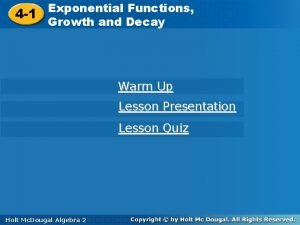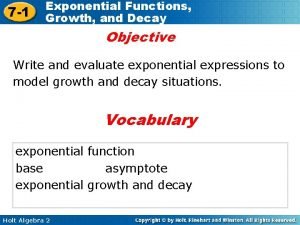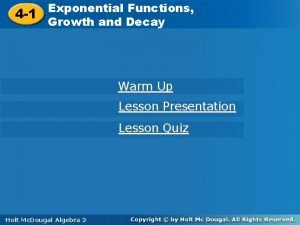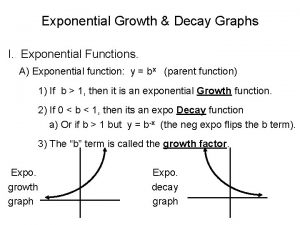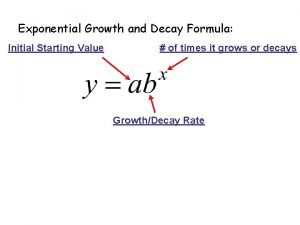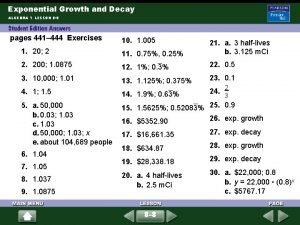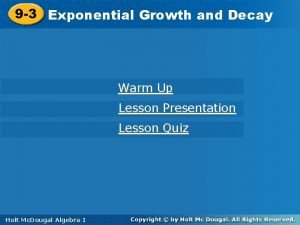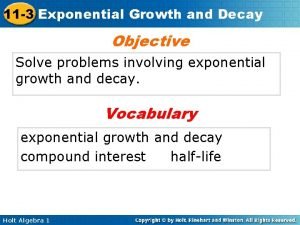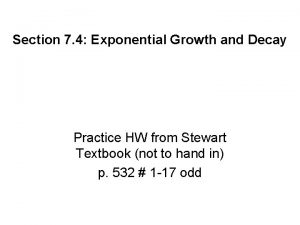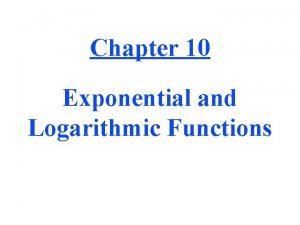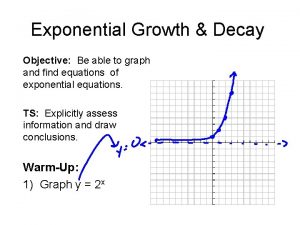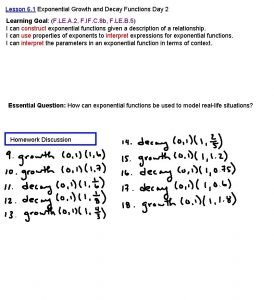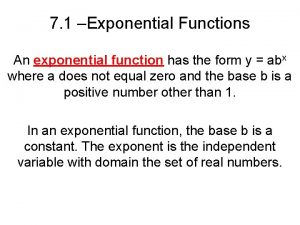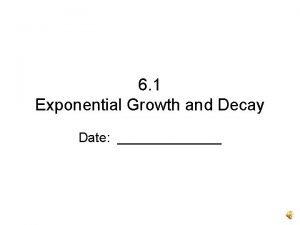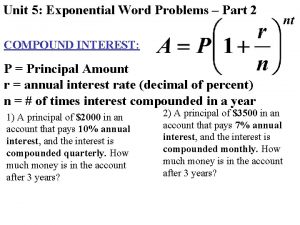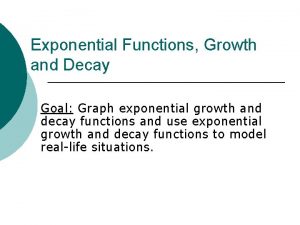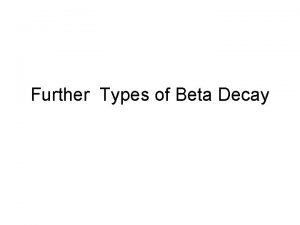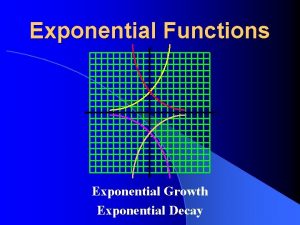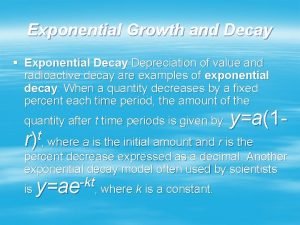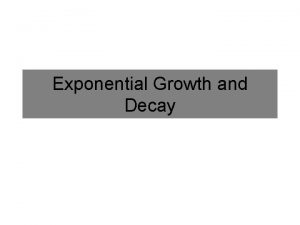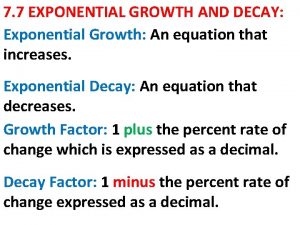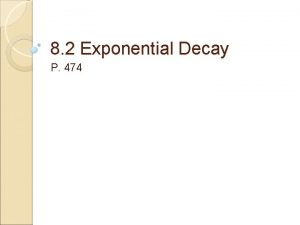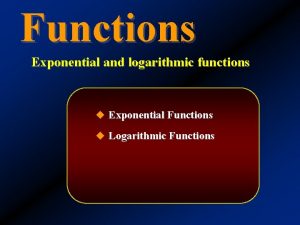Exponential Functions 4 1 Growth and Decay Growth




























- Slides: 28

Exponential Functions, 4 -1 Growth, and Decay Growth and Decay Warm Up Lesson Presentation Lesson Quiz Holt. Mc. Dougal Algebra 2 Holt

4 -1 Exponential Functions, Growth, and Decay Warm Up Evaluate. 1. 100(1. 08)20 ≈ 466. 1 2. 100(0. 95)25 ≈ 27. 74 3. 100(1 – 0. 02)10 ≈ 81. 71 4. 100(1 + 0. 08)– 10 ≈ 46. 32 Holt Mc. Dougal Algebra 2

4 -1 Exponential Functions, Growth, and Decay Objective Write and evaluate exponential expressions to model growth and decay situations. Holt Mc. Dougal Algebra 2

4 -1 Exponential Functions, Growth, and Decay Vocabulary exponential function base asymptote exponential growth exponential decay Holt Mc. Dougal Algebra 2

4 -1 Exponential Functions, Growth, and Decay Moore’s law, a rule used in the computer industry, states that the number of transistors per integrated circuit (the processing power) doubles every year. Beginning in the early days of integrated circuits, the growth in capacity may be approximated by this table. Holt Mc. Dougal Algebra 2

4 -1 Exponential Functions, Growth, and Decay Growth that doubles every year can be modeled by using a function with a variable as an exponent. This function is known as an exponential function. The parent exponential function is f(x) = bx, where the base b is a constant and the exponent x is the independent variable. Holt Mc. Dougal Algebra 2

4 -1 Exponential Functions, Growth, and Decay The graph of the parent function f(x) = 2 x is shown. The domain is all real numbers and the range is {y|y > 0}. Holt Mc. Dougal Algebra 2

4 -1 Exponential Functions, Growth, and Decay Notice as the x-values decrease, the graph of the function gets closer and closer to the x-axis. The function never reaches the x -axis because the value of 2 x cannot be zero. In this case, the x-axis is an asymptote. An asymptote is a line that a graphed function approaches as the value of x gets very large or very small. Holt Mc. Dougal Algebra 2

4 -1 Exponential Functions, Growth, and Decay A function of the form f(x) = abx, with a > 0 and b > 1, is an exponential growth function, which increases as x increases. When 0 < b < 1, the function is called an exponential decay function, which decreases as x increases. Holt Mc. Dougal Algebra 2

4 -1 Exponential Functions, Growth, and Decay Remember! In the function y = bx, y is a function of x because the value of y depends on the value of x. Remember! Negative exponents indicate a position change. For example: Holt Mc. Dougal Algebra 2

4 -1 Exponential Functions, Growth, and Decay Example 1 A: Graphing Exponential Functions Tell whether the function shows growth or decay. Then graph. Step 1 Find the value of the base. The base , , is less than 1. This is an exponential decay function. Holt Mc. Dougal Algebra 2

4 -1 Exponential Functions, Growth, and Decay Example 1 A Continued Step 2 Graph the function by using a table of values. x f(x) 0 2 4 6 8 10 12 10 5. 6 3. 2 1. 8 1. 0 0. 6 0. 3 Holt Mc. Dougal Algebra 2

4 -1 Exponential Functions, Growth, and Decay Example 1 B: Graphing Exponential Functions Tell whether the function shows growth or decay. Then graph. g(x) = 100(1. 05)x Step 1 Find the value of the base. g(x) = 100(1. 05)x Holt Mc. Dougal Algebra 2 The base, 1. 05, is greater than 1. This is an exponential growth function.

4 -1 Exponential Functions, Growth, and Decay Example 1 B Continued Step 2 Graph the function by using a graphing calculator. Holt Mc. Dougal Algebra 2

4 -1 Exponential Functions, Growth, and Decay Team Huddle Tell whether the function p(x) = 5(1. 2 x) shows growth or decay. Then graph. Step 1 Find the value of the base. p(x) = 5(1. 2 x) Holt Mc. Dougal Algebra 2 The base , 1. 2, is greater than 1. This is an exponential growth function.

4 -1 Exponential Functions, Growth, and Decay Team Huddle Step 2 Graph the function by using a table of values. x f(x) – 12 0. 56 Holt Mc. Dougal Algebra 2 – 8 1. 2 – 4 2. 4 0 5 4 8 10 10. 4 21. 5 30. 9

4 -1 Exponential Functions, Growth, and Decay You can model growth or decay by a constant percent increase or decrease with the following formula: In the formula, the base of the exponential expression, 1 + r, is called the growth factor. Similarly, 1 – r is the decay factor. Holt Mc. Dougal Algebra 2

4 -1 Exponential Functions, Growth, and Decay Helpful Hint X is used on the graphing calculator for the variable t: Y 1 =5000*1. 0625^X Holt Mc. Dougal Algebra 2

4 -1 Exponential Functions, Growth, and Decay Example 2: Economics Application Clara invests $5000 in an account that pays 6. 25% interest per year. After how many years will her investment be worth $10, 000? Step 1 Write a function to model the growth in value of her investment. f(t) = a(1 + r)t Exponential growth function. f(t) = 5000(1 + 0. 0625)t Substitute 5000 for a and 0. 0625 for r. f(t) = 5000(1. 0625)t Simplify. Holt Mc. Dougal Algebra 2

4 -1 Exponential Functions, Growth, and Decay Example 2 Continued Step 2 When graphing exponential functions in an appropriate domain, you may need to adjust the range a few times to show the key points of the function. Step 3 Use the graph to predict when the value of the investment will reach $10, 000. Use the feature to find the t-value where f(t) ≈ 10, 000. Holt Mc. Dougal Algebra 2

4 -1 Exponential Functions, Growth, and Decay Example 2 Continued Step 3 Use the graph to predict when the value of the investment will reach $10, 000. Use the feature to find the t-value where f(t) ≈ 10, 000. The function value is approximately 10, 000 when t ≈ 11. 43 The investment will be worth $10, 000 about 11. 43 years after it was purchased. Holt Mc. Dougal Algebra 2

4 -1 Exponential Functions, Growth, and Decay Team Huddle In 1981, the Australian humpback whale population was 350 and increased at a rate of 14% each year since then. Write a function to model population growth. Use a graph to predict when the population will reach 20, 000. P(t) = a(1 + r)t Exponential growth function. P(t) = 350(1 + 0. 14)t Substitute 350 for a and 0. 14 for r. P(t) = 350(1. 14)t Simplify. Holt Mc. Dougal Algebra 2

4 -1 Exponential Functions, Growth, and Decay Team Huddle Graph the function. Use to find when the population will reach 20, 000. It will take about 31 years for the population to reach 20, 000. Holt Mc. Dougal Algebra 2

4 -1 Exponential Functions, Growth, and Decay Example 3: Depreciation Application A city population, which was initially 15, 500, has been dropping 3% a year. Write an exponential function and graph the function. Use the graph to predict when the population will drop below 8000. f(t) = a(1 – r)t Exponential decay function. f(t) = 15, 500(1 – 0. 03)t Substitute 15, 500 for a and 0. 03 for r. f(t) = 15, 500(0. 97)t Simplify. Holt Mc. Dougal Algebra 2

4 -1 Exponential Functions, Growth, and Decay Example 3 Continued 10, 000 Graph the function. Use to find when the population will fall below 8000. 150 0 0 It will take about 22 years for the population to fall below 8000. Holt Mc. Dougal Algebra 2

4 -1 Exponential Functions, Growth, and Decay Team Huddle A motor scooter purchased for $1000 depreciates at an annual rate of 15%. Write an exponential function and graph the function. Use the graph to predict when the value will fall below $100. f(t) = a(1 – r)t Exponential decay function. f(t) = 1000(1 – 0. 15)t Substitute 1, 000 for a and 0. 15 for r. f(t) = 1000(0. 85)t Simplify. Holt Mc. Dougal Algebra 2

4 -1 Exponential Functions, Growth, and Decay Team Huddle 200 Graph the function. Use to find when the value will fall below 100 0 0 It will take about 14. 2 years for the value to fall below 100. Holt Mc. Dougal Algebra 2

4 -1 Exponential Functions, Growth, and Decay Team Mastery In 2000, the world population was 6. 08 billion and was increasing at a rate 1. 21% each year. 1. Write a function for world population. Does the function represent growth or decay? P(t) = 6. 08(1. 0121)t 2. Use a graph to predict the population in 2020. ≈ 7. 73 billion The value of a $3000 computer decreases about 30% each year. 3. Write a function for the computer’s value. Does the function represent growth or decay? V(t)≈ 3000(0. 7)t ≈ $720. 30 4. Use a graph to predict the value in 4 years. Holt Mc. Dougal Algebra 2
 7-1 exponential functions growth and decay
7-1 exponential functions growth and decay 6-3 lesson quiz exponential growth and decay
6-3 lesson quiz exponential growth and decay Growth and decay formula
Growth and decay formula 7-1 exponential functions growth and decay
7-1 exponential functions growth and decay Lesson 7-1 exponential functions growth and decay
Lesson 7-1 exponential functions growth and decay 4-1 exponential functions growth and decay
4-1 exponential functions growth and decay 4-1 exponential functions growth and decay
4-1 exponential functions growth and decay Growth and decay
Growth and decay Exponential growth and decay
Exponential growth and decay Decay or growth
Decay or growth Practice 8-8 exponential growth and decay
Practice 8-8 exponential growth and decay Exponential growth and decay formula
Exponential growth and decay formula 9-3 exponential growth and decay
9-3 exponential growth and decay 7-7 exponential growth and decay
7-7 exponential growth and decay Exponential growth and decay formula
Exponential growth and decay formula Poe growth and decay
Poe growth and decay Pert formula
Pert formula Identifying exponential growth and decay
Identifying exponential growth and decay Exponential function formula
Exponential function formula Growth and decay formula
Growth and decay formula Exponential decay or growth
Exponential decay or growth Exponential decay vs growth
Exponential decay vs growth Growth or decay exponential
Growth or decay exponential Growth or decay exponential
Growth or decay exponential Growth or decay exponential
Growth or decay exponential Decay factor
Decay factor Geometric growth population
Geometric growth population Beta minus decay vs beta plus decay
Beta minus decay vs beta plus decay Law of exponential decay
Law of exponential decay

